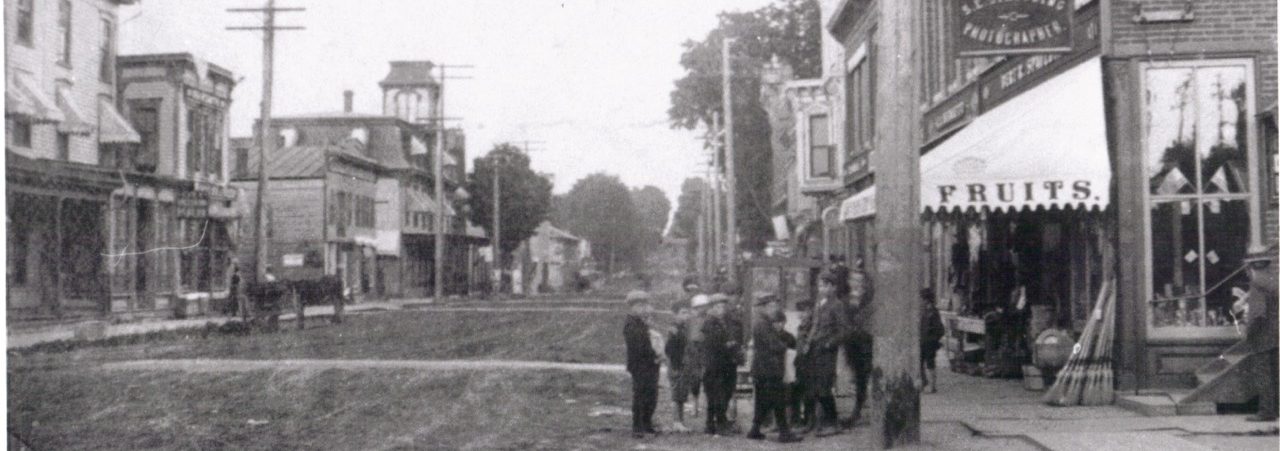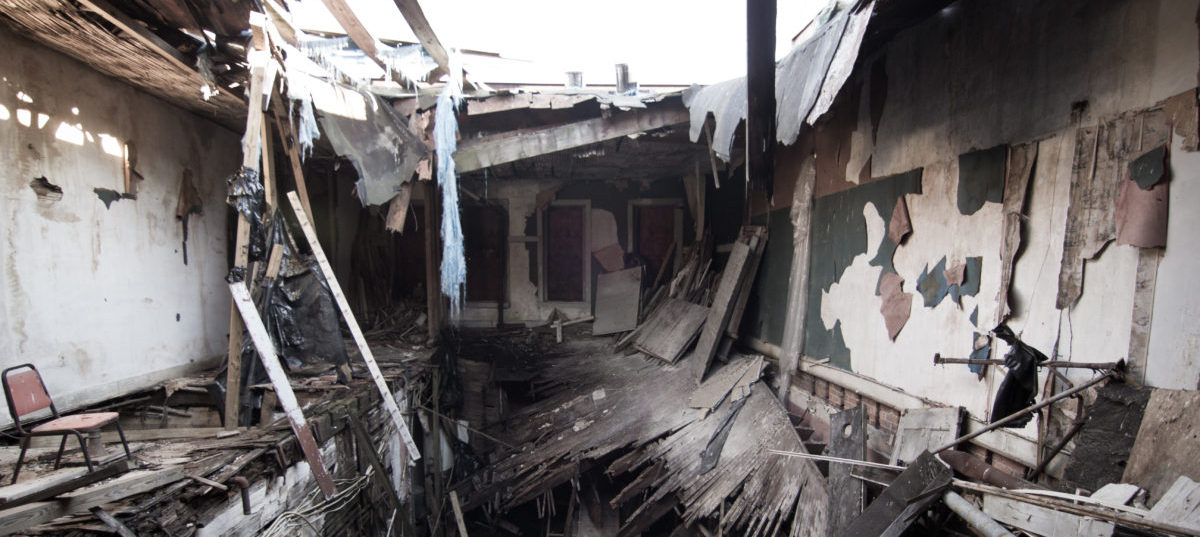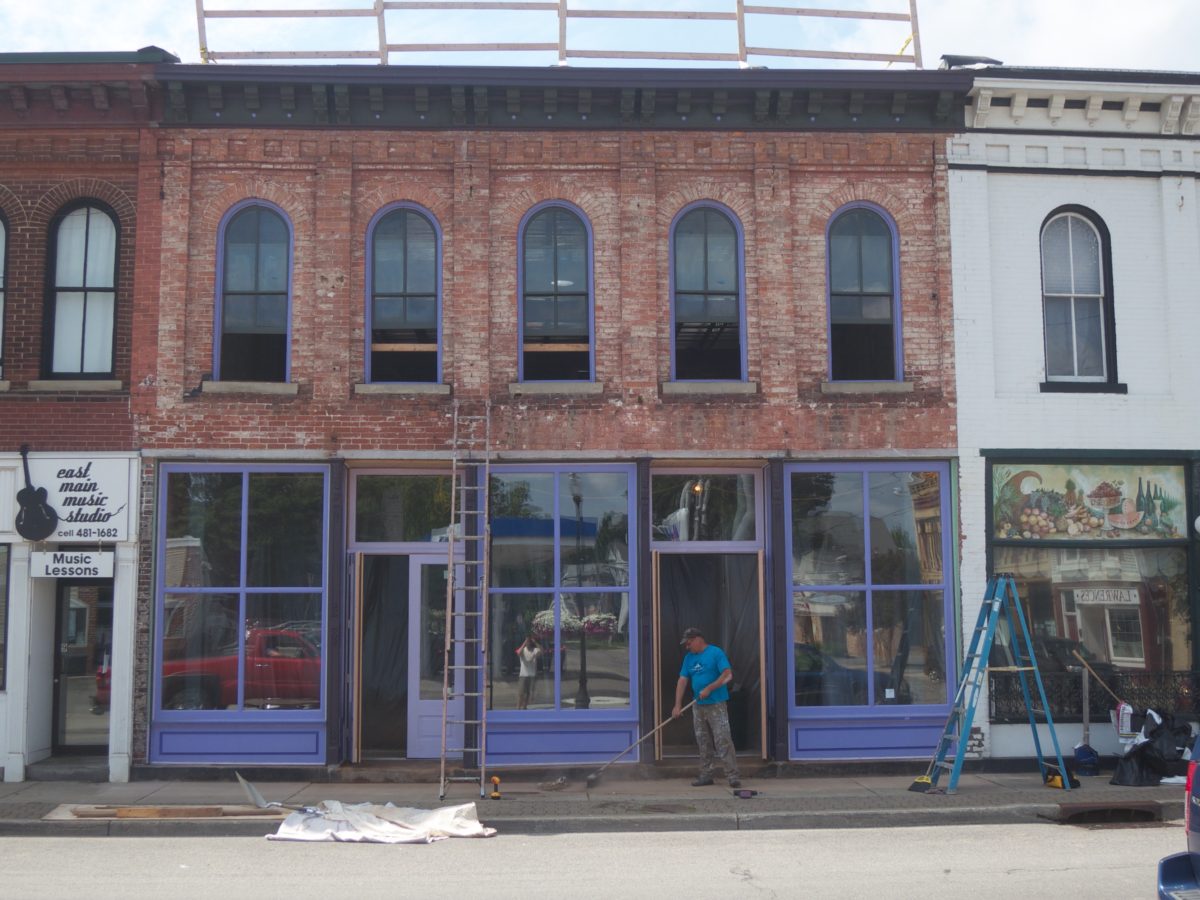
The Building located at 5 East Main Street is an important structure in the East Main-Mechanic Street Historic District of Springville because of its architectural and historic significance. The Building anchors the area at the center of the Village and it housed businesses which were of long duration and very prominent in the minds of village residents during the twentieth century. It is architecturally characteristic of the commercial architecture developed during Springville’s boom years.
Historical Significance of the Building
Five East Main is within a block of buildings that were constructed to replace those destroyed in one of Springville’s major fires when Hall’s Opera House burned on September 5, 1879. Its two-story height and brick construction are characteristic of the commercial buildings erected at this time when the village was beginning to grow rapidly. Thanks to the coming of the railroads to the town, its population nearly doubled between 1880 and 1896, and there was a great need for buildings to house the many shops, factories, and offices that served this growing population.
 The first establishments to occupy 5 East Main Street were a grocer in the western store and a hardware dealer in the eastern store. By 1892, a confectioner was located in the eastern half, and by 1904, H.B. Weir & Co. was selling boots and shoes where the grocer had been. C.M. Frank ran a bakery and the confectionary shop; the 1912 Sanborn Fire Insurance Map shows an oven in the basement. By at least 1924, the Odd Fellows were occupying a hall on the second floor, and in this hall in 1933 the Springville Rotary Club was organized.
The first establishments to occupy 5 East Main Street were a grocer in the western store and a hardware dealer in the eastern store. By 1892, a confectioner was located in the eastern half, and by 1904, H.B. Weir & Co. was selling boots and shoes where the grocer had been. C.M. Frank ran a bakery and the confectionary shop; the 1912 Sanborn Fire Insurance Map shows an oven in the basement. By at least 1924, the Odd Fellows were occupying a hall on the second floor, and in this hall in 1933 the Springville Rotary Club was organized.
 The 1948 Sanborn map shows the “Candy Kitchen” occupying the entire building. This was Teddy’s Candy Kitchen, a much-loved local restaurant and soda shop operated by Ted Sikaras, an immigrant from Greece.
The 1948 Sanborn map shows the “Candy Kitchen” occupying the entire building. This was Teddy’s Candy Kitchen, a much-loved local restaurant and soda shop operated by Ted Sikaras, an immigrant from Greece.
This local landmark was a social center for the community for several decades, and is described by longtime resident, Herbert Mosher: “The place was called  Ted’s Candy Kitchen. It served sodas, sundaes, sandwiches as well as candy and ice cream cones. It had a great soda fountain. It was operated by Ted Sikaras, who made his own candy and ice cream in the back rooms. Every teenager in Springville from the 1930s knew Ted’s. After school, teenagers flocked to the booths in the restaurant for Cokes® and to play the nickel jukebox.”
Ted’s Candy Kitchen. It served sodas, sundaes, sandwiches as well as candy and ice cream cones. It had a great soda fountain. It was operated by Ted Sikaras, who made his own candy and ice cream in the back rooms. Every teenager in Springville from the 1930s knew Ted’s. After school, teenagers flocked to the booths in the restaurant for Cokes® and to play the nickel jukebox.”
The bakery and restaurant business was continued by the  VanDermeer Bakery and Delicatessen in 1954, and later by Juul’s Bakery, started by one of the VanDermeer’s employees. On the second floor, Drs. Frederick and Jack Schweizer maintained their dental ofices for several decades, surviving a fire in October of 1955 that did $200,000 worth of damage to the easternmost building in what was then called the Kunn and Engel Block.
VanDermeer Bakery and Delicatessen in 1954, and later by Juul’s Bakery, started by one of the VanDermeer’s employees. On the second floor, Drs. Frederick and Jack Schweizer maintained their dental ofices for several decades, surviving a fire in October of 1955 that did $200,000 worth of damage to the easternmost building in what was then called the Kunn and Engel Block.

Architectural Description of Building
Very little original elements remained at the start of the project but great care was taken to return the building to its original design through replicated cast iron posts and wood-framed large scale windows. The second floor of the main façade is intact, with a cast iron lintel above the storefront, stone window sills, brick pilasters separating the five round-headed window openings topped with brick corbels and squares, and surmounted by a metal cornice featuring small modillions set between pairs of larger modillions placed above the pilasters. The original sashes remain in all five windows, and the masonry and cornice were recently restored.
 The rear elevation faces an alley that runs parallel to Main Street. A recent acquisition of several feet of property will allow for the construction of an ADA compliant rear entrance. The rear wall’s structural integrity failed due to years of water penetration and after a delicate dismantling of the wall, it was rebuilt with the same exterior brick and windows but now supported by a steel structure. The second story retains its original fenestration, five segmentally arched window openings, with a two-over-two sash. The first story has undergone numerous changes over the years but now approximates what is thought to be the original with four new windows and a single door.
The rear elevation faces an alley that runs parallel to Main Street. A recent acquisition of several feet of property will allow for the construction of an ADA compliant rear entrance. The rear wall’s structural integrity failed due to years of water penetration and after a delicate dismantling of the wall, it was rebuilt with the same exterior brick and windows but now supported by a steel structure. The second story retains its original fenestration, five segmentally arched window openings, with a two-over-two sash. The first story has undergone numerous changes over the years but now approximates what is thought to be the original with four new windows and a single door.
At the start of the project, the flat roof had completely failed and had an enormous hole, through which the elements had been entering the building for years. Consequently, all the interior structure – roof, first and second floors – had deteriorated to the point of collapse. Since that time, the building was abated and debris removed. The original dry-stacked stone basement walls were left intact while the basement level was lowered several feet, new footings poured and an elevator shaft constructed. From that new foundation, a heavy-duty steel structure was built within the existing common walls. The subfloor and stairs were installed at each level and the roof rebuilt.
The roof now features several elevation shifts to reduce visibility of the elevator shaft and penthouse which allows access to a green roof. Installed in 2015, the roof is now fairly mature and provides a major amenity to the building. Raised beds, extensive areas, garden like spaces with shrubs and a small deck area link the food served below to ingredients growing above. The penthouse, complete with Italianate design that echoes the street-level facade, provides year-round viewing of the roof and Main Street beyond.
